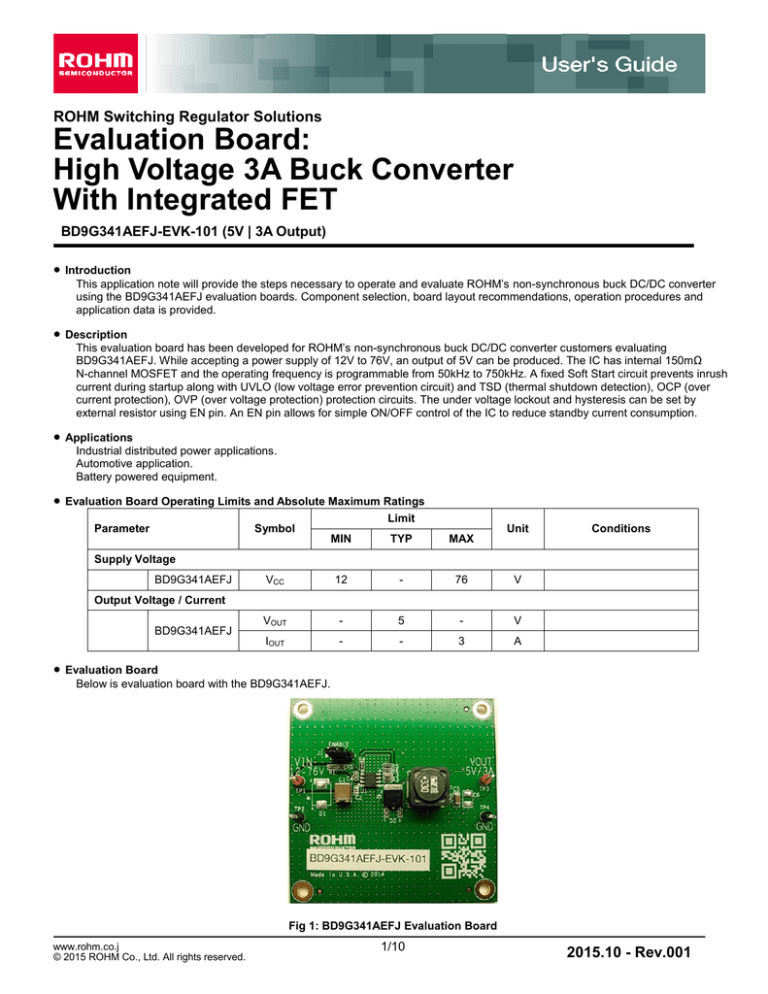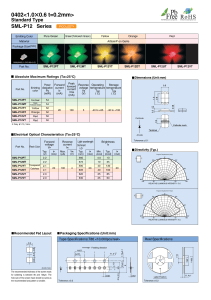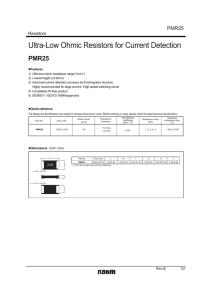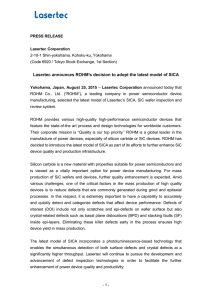
ROHM Switching Regulator Solutions
Evaluation Board:
High Voltage 3A Buck Converter
With Integrated FET
BD9G341AEFJ-EVK-101 (5V | 3A Output)
Introduction
This application note will provide the steps necessary to operate and evaluate ROHM’s non-synchronous buck DC/DC converter
using the BD9G341AEFJ evaluation boards. Component selection, board layout recommendations, operation procedures and
application data is provided.
Description
This evaluation board has been developed for ROHM’s non-synchronous buck DC/DC converter customers evaluating
BD9G341AEFJ. While accepting a power supply of 12V to 76V, an output of 5V can be produced. The IC has internal 150mΩ
N-channel MOSFET and the operating frequency is programmable from 50kHz to 750kHz. A fixed Soft Start circuit prevents inrush
current during startup along with UVLO (low voltage error prevention circuit) and TSD (thermal shutdown detection), OCP (over
current protection), OVP (over voltage protection) protection circuits. The under voltage lockout and hysteresis can be set by
external resistor using EN pin. An EN pin allows for simple ON/OFF control of the IC to reduce standby current consumption.
Applications
Industrial distributed power applications.
Automotive application.
Battery powered equipment.
Evaluation Board Operating Limits and Absolute Maximum Ratings
Parameter
Symbol
Limit
Unit
MIN
TYP
MAX
VCC
12
-
76
V
VOUT
-
5
-
V
IOUT
-
-
3
A
Conditions
Supply Voltage
BD9G341AEFJ
Output Voltage / Current
BD9G341AEFJ
Evaluation Board
Below is evaluation board with the BD9G341AEFJ.
Fig 1: BD9G341AEFJ Evaluation Board
www.rohm.co.j
© 2015 ROHM Co., Ltd. All rights reserved.
p
1/10
2015.10 - Rev.001
BD9G341AEFJ-EVK-001
Evaluation Board Schematic
Below is evaluation board schematic for BD9G341AEFJ.
Fig 2: BD9G341AEFJ Evaluation Board Schematic
Evaluation Board I/O
Below is reference application circuit that shows the inputs (VIN and EN) and the output (VOUT).
Fig 3: BD9G341AEFJ Evaluation Board I/O
Evaluation Board Operation Procedures
Below is the procedure to operate the evaluation board.
1. Connect power supply’s GND terminal to GND test point TP2 on the evaluation board.
2. Connect power supply’s VCC terminal to VIN test point TP1 on the evaluation board. This will provide VIN to the IC U1. Please note
that the VCC should be in range of 12V to 76V.
3. Check if shunt jumper of J1 is at position ON (Pin2 connect to Pin1, EN pin of IC U1 is pulled high).
4. Connect electronic load to TP3 and TP4. Do not turn on load (electronic load is off power).
5. Turn on power supply. The output voltage VOUT(+5V) can be measured at the test point TP3. Now turn on the load. The load can
be increased up to 3A MAX.
Notes:
The board does not support hot plugging protection. Do not perform hot plugging on this board.
www.rohm.co.jp
© 2015 ROHM Co., Ltd. All rights reserved.
www.rohm.co.j
p
2/10
2015.10 - Rev.001
BD9G341AEFJ-EVK-001
Reference Application Data for BD9G341AEFJ-EVK-101
Following graphs show quiescent current, efficiency, load response, output voltage ripple response of the BD9G341AEFJ evaluation
board.
Fig 4: Circuit Current vs. Power supply
o
Voltage Characteristics (Temp=25 C)
Fig 6: Load Response Characteristics
(VIN=48V, VOUT=5V, IOUT=03A)
Fig 8: Output Voltage Ripple Response Characteristics
(VIN=48V, VOUT=5V, IOUT=0A)
www.rohm.co.jp
© 2015 ROHM Co., Ltd. All rights reserved.
www.rohm.co.j
p
Fig 5: Electric Power Conversion Rate
(VIN=48V, VOUT=5V)
Fig 7: Load Response Characteristics
(VIN=48V, VOUT=5V, IOUT=3A0A)
Fig 9: Output Voltage Ripple Response Characteristics
(VIN=48V, VOUT=5V, IOUT=3A)
3/10
2015.10 - Rev.001
BD9G341AEFJ-EVK-001
Evaluation Board Layout Guidelines
Layout is a critical portion of good power supply design. There are several signals paths that conduct fast changing currents
or voltages that can interact with stray inductance or parasitic capacitance to generate noise or degrade the power supplies
performance. To help eliminate these problems, the VCC pin should be bypassed to ground with a low ESR ceramic bypass
capacitor with B dielectric. Care should be taken to minimize the loop area formed by the bypass capacitor connections, the
VCC pin, and the anode of the catch diode. The GND pin should be tied directly to the thermal pad under the IC and the thermal
pad. In order to reduce the influence of the impedance and L of the parasitic, the high current line is thick and short.
Input decoupling capacitor should be located as close to the VCC pins.
In order to minimize the parasitic capacitor and impedance of pattern, catch diode and inductance should be located as
close to the Lx pin.
The thermal pad should be connected to any internal PCB ground planes using multiple VIAs directly under the IC.
GND feedback resistor, phase compensation element and RT resistor don’t give the common impedance resistor against
high current line…
Top Layer
Bottom Layer
Fig 10: BD9G341AEFJ-E2EVK-101 and BD9G341AEFJ-EVK-101 Board PCB layout
www.rohm.co.jp
© 2015 ROHM Co., Ltd. All rights reserved.
www.rohm.co.j
p
4/10
2015.10 - Rev.001
BD9G341AEFJ-EVK-001
o
Fig 11: BD9G341AEFJ-E2EVK-101 Thermal Characteristics at Temp=25 C, No air flow, VIN=76V,
VOUT=5V, IOUT=3A. Thermal characteristics also apply to BD9G341AEFJ-EVK-101.
o
Thermal note: If the board is operated above room temperature (T>25 C), an active cooling source (fan) or heat sink (soldered to
bottom of PCB) need to be added.
Additional layout notes:
The thermal Pad on the back side of IC has the great thermal conduction to the chip. So using the GND plane as broad and wide
as possible can help thermal dissipation. And a lot of thermal via for helping the spread of heat to the different layer is also
effective.
The input capacitors should be connected to GND as close as possible to the VIN terminal.
The inductor and the output capacitors should be placed close to SW pin as much as possible.
For applications operating at or near maximum voltage conditions (76V max), additional precautions regarding heat dissipation
need to be considered during board layout. The provided evaluation board is a 4-layer board meant for evaluation purposes only.
At maximum conditions, the IC’s internal thermal shutdown detection circuit will be potentially initiated and the output disabled until
the junction temperature falls. For final designs operating near these conditions, we recommend using one of the below PCB
options for better heat dissipation of the IC.
1)
Use of a 4-layer PCB with internal GND planes connected to the IC GND pins.
2)
Use of a 2-layer PCB with a heat sink attached to the IC package.
3)
Use of a 2-layer PCB with a copper plane (>1oz) attached to the IC.
www.rohm.co.jp
© 2015 ROHM Co., Ltd. All rights reserved.
www.rohm.co.j
p
5/10
2015.10 - Rev.001
BD9G341AEFJ-EVK-001
Calculation of Application Circuit Components
1. Inductors
Something of the shield type that fulfills the current rating (Current value Ipeak below), with low DCR is recommended.
Value of Inductance influences Inductor Ripple Current and becomes the cause of Output Ripple.
In the same way as the formula below, this Ripple Current can be made small for as big as the L value of Coil or as high as the
Switching Frequency.
Fig 12: Inductor Current
𝐈𝐏𝐄𝐀𝐊 = 𝐈𝐎𝐔𝐓 +
∆𝐈𝐋 =
𝐕𝐂𝐂 −𝐕𝐎𝐔𝐓
𝐋
∆𝐈𝐋
𝟐
×
… (𝟏)
𝐕𝐎𝐔𝐓
𝐕𝑪𝑪
𝟏
× 𝐟 … (𝟐)
(∆IL: Output Ripple Current, VCC: Input Voltage, VOUT: Output Voltage, f: Switching Frequency)
For design value of Inductor Ripple Current, please carry out design tentatively with about 20%~50% of Maximum Input
Current.
In the BD9G341AEFJ, it is recommended the below series of 4.7μH~33μH inductance value.
Recommended Inductor:SUMIDA CDRH127H Series
2.
Output Capacitor
In order for capacitor to be used in output to reduce output ripple, Low ceramic capacitor of ESR is recommended.
Also, for capacitor rating, on top of putting into consideration DC Bias characteristics, please use something whose maximum
rating has sufficient margin with respect to the Output Voltage.
Output ripple voltage is looked for using the following formula.
𝟏
𝐕𝐏𝐏 = ∆𝐈𝐋 × 𝟐𝛑×𝐟×𝐂
𝐎𝐔𝐓
+ ∆𝐈𝐋 × 𝐑 𝐄𝐒𝐑
. . . (𝟑)
Please design in a way that it is held within Capacity Ripple Voltage.
In the BD9G341AEFJ, it is recommended a ceramic capacitor over 10μF.
3.
Output voltage setting
The internal reference voltage of ERROR AMP is 1.0V.
Fig 13: Output voltage setting
www.rohm.co.jp
© 2015 ROHM Co., Ltd. All rights reserved.
www.rohm.co.j
p
6/10
2015.10 - Rev.001
BD9G341AEFJ-EVK-001
Output voltage is determined like (4) types
𝐕𝐎𝐔𝐓 =
𝐑𝟏 + 𝐑𝟐
. . . (𝟒)
𝐑𝟐
4.
Bootstrap Capacitor
Please connect from 0.1uF (Laminate Ceramic Capacitor) between BST Pin and Lx Pins.
5.
Catch Diode
BD9G341AEFJ should be taken to connect external catch diode between Lx Pin and GND Pin. The diode require adherence to
absolute maximum Ratings of application. Opposite direction voltage should be higher than maximum voltage of Lx Pin (VCCMAX
+ 0.5V). The peak current is required to be higher than I OUTMAX +∆IL.
6.
Input Capacitor
BD9G341AEFJ needs an input decoupling capacitor. It is recommended a low ceramic capacitor ESR over 4.7μF . Additionally, it
should be located as close as possible.
Capacitor should be selected by maximum input voltage with input ripple voltage.
Input ripple voltage is calculated by using the following formula.
∆𝐕𝐂𝐂 =
𝐈𝐎𝐔𝐓
𝐟×𝐂𝐕𝐂𝐂
×
𝐕𝐎𝐔𝐓
𝐕𝐂𝐂
× [𝟏 −
𝐕𝐎𝐔𝐓
]
𝐕𝐂𝐂
. . . (𝟓)
CVCC: Input capacitor
RMS ripple current is calculated by using the following formula.
𝐕
𝐈𝐂𝐕𝐂𝐂 = 𝐈𝐎𝐔𝐓 × √ 𝐕𝐎𝐔𝐓 × (𝟏 −
𝐂𝐂
𝐕𝐎𝐔𝐓
)
𝐕𝐂𝐂
. . . (𝟔)
If VCC=2VOUT, RMS ripple current is maximum. That is determined by (9) .
𝐈𝐂𝐕𝐂𝐂_𝐦𝐚𝐱 =
7.
𝐈𝐎𝐔𝐓
𝟐
. . . (𝟕)
About Adjustment of DC/DC Comparator Frequency Characteristics
Role of Phase compensation element C1, C2, R3.
Fig 14: Feedback voltage resistance setting method
Stability and Responsiveness of Loop are controlled through VC Pin which is the output of Error Amp.
The combination of zero and pole that determines Stability and Responsiveness is adjusted by the combination of resistor and
capacitor that are connected in series to the VC Pin.
DC Gain of Voltage Return Loop can be calculated for using the following formula.
𝐕
𝐅𝐁
𝐀𝐝𝐜 = 𝐑 𝐥 × 𝐆𝐂𝐒 × 𝐀𝐕𝐄𝐀 × 𝐕𝐨𝐮𝐭
. . . (𝟖)
www.rohm.co.jp
© 2015 ROHM Co., Ltd. All rights reserved.
www.rohm.co.j
p
7/10
2015.10 - Rev.001
BD9G341AEFJ-EVK-001
Here, VFB is Feedback Voltage (1.0V).AEA is Voltage Gain of Error amplifier (typ: 55.6dB), Gcs is the Trans-conductance of Current
Detect (typ: 10A/V), and Rl is the Output Load Resistance value.
There are 2 important poles in the Control Loop of this DC/DC.
The first occurs with/ through the output resistance of Phase compensation Capacitor (C1) and Error amplifier.
The other one occurs with/through the Output Capacitor and Load Resistor.
These poles appear in the frequency written below.
𝐆
𝐄𝐀
𝐟𝐩𝟏 = 𝟐𝛑×𝐂𝟏×𝐀
𝐟𝐩𝟐 = 𝟐𝛑×𝐂
. . . (𝟗)
𝐕𝐄𝐀
𝟏
𝐎𝐔𝐓 ×𝐑 𝐥
. . . (𝟏𝟎)
Here, GEA is the trans-conductance of Error amplifier (typ: 300 µA/V).
Here, in this Control Loop, one zero becomes important. With the zero which occurs because of Phase compensation Capacitor
C1 and Phase compensation Resistor R3, the Frequency below appears.
𝟏
𝐟𝐳𝟏 = 𝟐𝛑×𝐂𝟏×𝐑𝟑 . . . (𝟏𝟏)
Also, if Output Capacitor is big, and that ESR (RESR) is big, in this Control Loop, there are cases when it has an important,
separate zero (ESR zero).
This ESR zero occurs due to ESR of Output Capacitor and Capacitance, and exists in the Frequency below.
𝐟𝐳𝐄𝐒𝐑 = 𝟐𝛑×𝐂
𝟏
𝐎𝐔𝐓 ×𝐑 𝐄𝐒𝐑
. . . (𝟏𝟐)
rd
(ESR zero)
nd
In this case, the 3 pole determined with the 2 Phase compensation Capacitor (C2) and Phase Correction Resistor (R3) is used
in order to correct the ESR zero results in Loop Gain.
This pole exists in the frequency shown below.
𝐟𝐩𝟑 =
𝟏
𝟐𝛑×𝐂𝟐×𝐑𝟑
. . . (𝟏𝟑)
(pole that corrects ESR zero)
The target of Phase compensation design is to create a communication function in order to acquire necessary band and Phase
margin.
Cross-over Frequency (band) at which Loop gain of Return Loop becomes “0” is important.
When Cross-over Frequency becomes low, Power supply Fluctuation Response, Load Response, etc worsens.
On the other hand, when Cross-over Frequency is too high, instability of the Loop can occur.
Tentatively, Cross-over Frequency is targeted to be made 1/20 or below of Switching Frequency.
Selection method of Phase Compensation constant is shown below.
1.
Phase Compensation Resistor (R3) is selected in order to set to the desired Cross-over Frequency.
Calculation of RC is done using the formula below.
𝐑𝟑 =
𝟐𝛑×𝐂𝐎𝐔𝐓 ×𝐟𝐜
𝐆𝐄𝐀 ×𝐆𝐂𝐒
×
𝐕𝐎𝐔𝐓
𝑽𝐅𝐁
. . . (𝟏𝟒)
Here, fc is the desired Cross-over Frequency. It is made about 1/20 and below of the Normal Switching Frequency (fs).
2.
Phase compensation Capacitor (C1) is selected in order to achieve the desired phase margin.
In an application that has a representative Inductance value (about several 4.7µH~33µH), by matching zero of
compensation to 1/4 and below of the Cross-over Frequency, sufficient Phase margin can be acquired. C1 can be
calculated using the following formula.
𝟒
𝐂𝟏 > 𝟐𝛑×𝐑𝟑×𝐟 . . . (𝟏𝟓)
𝐜
3.
Examination whether the second Phase compensation Capacitor C2 is necessary or not is done.
If the ESR zero of Output Capacitor exists in a place that is smaller than half of the Switching Frequency, a second Phase
compensation Capacitor is necessary. In other words, it is the case wherein the formula below happens.
𝟏
𝟐𝛑×𝐂𝐎𝐔𝐓 ×𝐑 𝐄𝐒𝐑
<
𝐟𝐬
𝟐
. . . (𝟏𝟔)
www.rohm.co.jp
© 2015 ROHM Co., Ltd. All rights reserved.
www.rohm.co.j
p
8/10
2015.10 - Rev.001
BD9G341AEFJ-EVK-001
In this case, add the second Phase compensation Capacitor C2, and match the frequency of the third pole to the Frequency
fp3 of ESR zero.
𝐂𝟐 =
𝐂𝐎𝐔𝐓 ×𝐑 𝐄𝐒𝐑
𝐑𝟑
. . . (𝟏𝟕)
Evaluation Board BOM
Below is a table with the build of materials. Part numbers and supplier references are provided.
Item
Qty.
Ref
Description
Manufacturer
Part Number
1
1
C1
CAP CER 10UF 100V 20% X7R SMD
Murata Electronics North America
KRM55TR72A106MH01K
2
1
C3
CAP CER 6800PF 50V 10% X7R 0603
Murata Electronics North America
GRM188R71H682KA01D
3
1
C4
CAP CER 0.1UF 50V 10% X7R 0603
Murata Electronics North America
GRM188R71H104KA93D
4
1
C5
CAP CER 100UF 6.3V 20% X5R 1206
Murata Electronics North America
GRM31CR60J107ME39L
5
1
D2
DIODE SCHOTTKY 90V 3A CPD
Rohm
RB095B-90TL
6
1
J1
CONN HEADER VERT .100 3POS 15AU
FCI
68000-103HLF
7
1
L1
INDUCTOR POWER 33UH 4.2A SMD
Wurth Electronics Inc
7447709330
8
1
R1
RES 110K OHM 1/10W 1% 0603 SMD
Rohm
MCR03ERTF1103
9
1
R2
RES 27K OHM 1/10W 1% 0603 SMD
Rohm
MCR03ERTF2702
10
1
R3
RES 10K OHM 1/10W 1% 0603 SMD
Rohm
MCR03ERTF1002
11
1
R4
RES 47K OHM 1/10W 1% 0603 SMD
Rohm
MCR03ERTF4702
12
1
R5
RES 3K OHM 1/10W 1% 0603 SMD
Rohm
MCR03ERTF3001
13
1
R6
RES 750 OHM 1/10W 1% 0603 SMD
Rohm
MCR03ERTF7500
14
2
TP1,TP3
TEST POINT PC MULTI PURPOSE RED
Keystone Electronics
5010
15
2
TP2,TP4
TEST POINT PC MULTI PURPOSE BLK
Keystone Electronics
5011
16
1
U1
IC REG BUCK SYNC ADJ 3A HTSOP-J8
Rohm
BD9G341AEFJ-E2
www.rohm.co.jp
© 2015 ROHM Co., Ltd. All rights reserved.
www.rohm.co.j
p
9/10
2015.10 - Rev.001
BD9G341AEFJ-EVK-001
Notes
No copying or reproduction of this document, in part or in whole, is permitted without the consent of
ROHM Co.,Ltd.
The content specified herein is subject to change for improvement without notice.
The content specified herein is for the purpose of introducing ROHM's products (herein after "Products").
If you wish to use any such Product, please be sure to refer to the specifications which can be obtained
from ROHM upon request.
Examples of application circuits, circuit constants and any other information contained herein illustrate
the standard usage and operations of the Products. The peripheral conditions must be taken into
account when designing circuits for mass production.
Great care was taken in ensuring the accuracy of the information specified in this document. However,
should you incur any damage arising from any inaccuracy or misprint of such information, ROHM shall
bear no responsibility for such damage.
The technical information specified herein is intended only to show the typical functions of and examples
of application circuits for the Products. ROHM does not grant you, explicitly or implicitly, any license to
use or exercise intellectual property or other rights held by ROHM and other parties. ROHM shall bear no
responsibility whatsoever for any dispute arising from the use of such technical information.
The Products specified in this document are intended to be used with general-use electronic equipment
or devices (such as audio visual equipment, office-automation equipment, communication devices,
electronic appliances and amusement devices).
The Products specified in this document are not designed to be radiation tolerant.
While ROHM always makes efforts to enhance the quality and reliability of its Products, a Product may
fail or malfunction for a variety of reasons.
Please be sure to implement in your equipment using the Products safety measures to guard against the
possibility of physical injury, fire or any other damage caused in the event of the failure of any Product,
such as derating, redundancy, fire control and fail-safe designs. ROHM shall bear no responsibility
whatsoever for your use of any Product outside of the prescribed scope or not in accordance with the
instruction manual.
The Products are not designed or manufactured to be used with any equipment, device or system which
requires an extremely high level of reliability the failure or malfunction of which may result in a direct
threat to human life or create a risk of human injury (such as a medical instrument, transportation
equipment, aerospace machinery, nuclear-reactor controller, fuel-controller or other safety device).
ROHM shall bear no responsibility in any way for use of any of the Products for the above special
purposes. If a Product is intended to be used for any such special purpose, please contact a ROHM
sales representative before purchasing.
If you intend to export or ship overseas any Product or technology specified herein that maybe controlled
under the Foreign Exchange and the Foreign Trade Law, you will be required to obtain a license or
permit under the Law.
Thank you for your accessing to ROHM product information.
More detail product information and catalogs are available, please contact us.
ROHM Customer Support System
http://www.rohm.com/contact/
www.rohm.co.jp
© 2015 ROHM Co., Ltd. All rights reserved.
www.rohm.co.j
p
10/10
2015.10 - Rev.001




